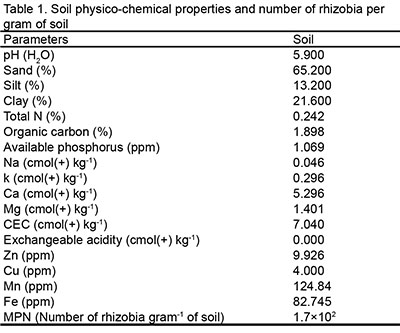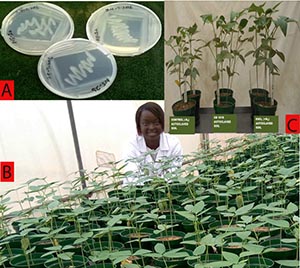For Nigeria Nkeki Kamai chose this article from Podcaster 39, September 2016 as from recent developments in Ojo’s work the answer to that question is YES. If a functional inoculant for cowpea can be developed from work of a N2Africa student then this is one of the greatest news for Nigeria. Remember Nigeria is the largest producer, the largest consumer and the largest net importer of cowpea in Africa.
|
The success of cowpea response to inoculation with effective rhizobia strain in presence of indigenous rhizobia depends on three factors; population density, effectiveness and competitive ability of native African rhizobia. The major aim of my research is to explore the potential benefits of rhizobia inoculation with cowpea in northern Nigeria (Picture 1). This study examined the response of cowpea cultivar to inoculation with different rhizobia strains. Cowpea cultivar IT97K-499-35 was inoculated with ten different rhizobia strains and two controls (twelve treatments in total), in soil (autoclaved) collected from field without history of cowpea cultivation and inoculant usage. The history of the soil is indicated in Table 1, showing that the soil contained the appropriate level of rhizobia necessary to nodulate cowpea (100 rhizobia cells gram-1 of soil). |
Picture 1. (A) Growing rhizobia strains, (B) Ojo Comfort in the greenhouse with growing cowpea and (C) growth response of cowpea to three different treatments |
 |
As shown in Figure 2A, rhizobia strain CB 1015 nodulated cowpea the most, while there was no significant difference in the dry weight of shoot (Figure 2B) of rhizobia strain 2NAG91a and treatment control N (without inoculation, but with KNO3). In Figure 2C, rhizobia strains CB756 and NAG5261 fixed the most nitrogen, as compared to the other treatments applied in this experiment. As indicated by the result of shoot dry weight, cowpea showed positive response to inoculation with strain 2NAG91a compared to the treatment with KNO3 (control N) and without nitrogen source (control NO). These strains (CB756, NAG5261 and 2NAG91a) are all indigenous to African soil. The performance of the Brazilian strain (BR 3262 and BR 3267), known to be highly effective with cowpea, performed less compared to these indigenous African strains. Consequently, there is a need to identify elite strains of cowpea that are indigenous to African soils and develop them as inoculant for cowpea. |

Ojo Comfort, Wageningen University, The Netherlands (Click here for her 2015 update)

